"Connected Andover" - The story of a Love Affair with Asphalt
The long and winding path
Last summer, Andover proudly announced winning the $500,000 grant for Masstrails touting the project’s primary goal: providing improved access to the disabled. The trail, we were told, was necessary to address longstanding inequities in Andover whereby the disabled were prevented from accessing nature. It was claimed that the existing rail bed and flat surface provided an ideal location to construct a path compliant with the Americans with Disabilities Act (ADA) that would ensure access to the views, varied forested terrain and peaceful natural setting: the tree lined rim of the pond, the vaulted ceiling of pines and oaks midway up the trail, an ancient farm field long since converted by mother nature into a lovely meadow, and more unique features.
To provide our beloved neighbors access to all of these sights, Project Manager Janet Nicosia and Deputy Town Manager Michael Lindstrom – assisted by their intended contractor, BSC Group – told us that we must excavate a fourteen foot wide furrow up the full length of this long dormant rail bed, seeding it with fresh gravel fill and topping it with several tons of asphalt. Only a solution that covered an acre of land with bitumen paving, within a few feet of our drinking water supply, would ensure “full access.” At its January 8 meeting, the Select Board opined from its dais that this was a “civil rights issue,” in response to a half dozen residents’ statements.
Asphalt paving and a 10 foot width, we’ve been told, is the only way to ensure equal access in our community. A wide trail is necessary for wheelchair users easily access a new boardwalk that the Conservation Commission would never have approved for an individual abutter. Asphalt makes the journey fast and smooth, justifying the environmental cost and the loss of trees.
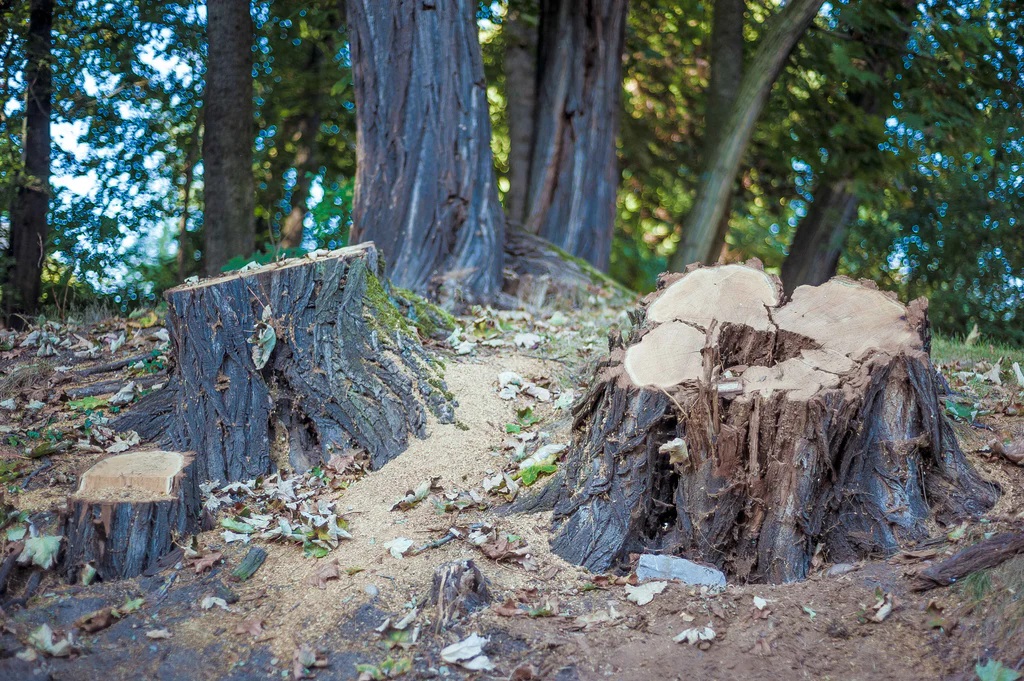
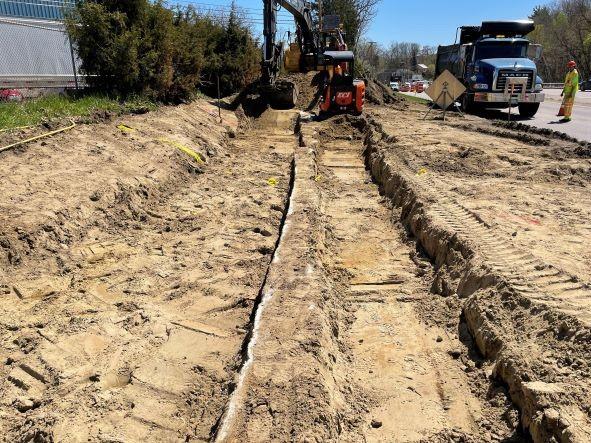
Cracks in the Asphalt
Friends of Haggetts Pond supports equal access for the disabled. We would prefer to spend time with friends, family, pets, or our careers than seek signatures for petitions, argue with strangers on Facebook or upset our friends and neighbors with questions and concerns that some have termed “exclusive” and even “bigoted.” Nevertheless, when told that BSC Group’s designs and the selected trail location were the only ways to provide an accessible trail in Andover, a few of us decided to research these claims. Like the cracks in pavement through which grass, clover and dandelions elbow their way toward the sun after the first Spring rain, oddities and inconsistencies in the town’s narrative emerged.
Misleading Statements – the town issued numerous statements suggesting that asphalt is required for ADA accessibility (along with other features like the initial 14 ft. width including shoulders. Select Board Melissa Danisch called the issue a “civil rights” issue suggesting that anything less than the BSC Group’s design would deprive disabled residents of their rights. More recently, the town published a Haggetts Pond Site Selection web page, which states, “… for people with disabilities to enjoy recreational opportunities and ensure compliance with the Americans with Disabilities Act (ADA) has been a longstanding priority of the Town of Andover. In order to advance this goal, a multi-disciplinary group of Town staff and community members assessed several sites on Town land to determine their suitability for a shared use trail.”
The term “shared use” is not accidental. It is defined in a particular way by the Massachusetts Department of Transportation guidelines : a paved path using asphalt or similar hard surface, at least 10 foot wide.
The actual ADA requirements are a firm surface, which can include stone dust, and a 3 ft. width. See Massachusetts Parks & Recreation web site as well as the U.S. Forest Service Accessibility Guidelines which are the definitive guides for accessibility. Most accessible trails managed by the Commonwealth of Massachusetts conform to the USFSAG standards.
Why, we wondered, did the town continue claim that a wide asphalt byway was required for accessibility when regulations and guidelines indicated otherwise?
Dogged Determination and a Rushed Timetable – other Andover projects have been released with enough time for public input and engagement. For example, the Shawsheen River master plan was first announced in 2022, and numerous public meetings have been held since. The plan has changed along the way with resident input, evolving into something backed by consensus.
The Haggetts Pond asphalt-paved “shared use” path, on the other hand, had its first public hearing in August 2023 after approval of funding. Project proponents stated that work would be start soon and yet the project’s web page appeared in November of 2023. Despite this and numerous delays imposed by regulatory review, the town has issued multiple statements that they intend to complete construction in 2024.
Why, we wondered, was the town in such a hurry to start the project that it applied for grant funding on the basis of a design that had not received public input or the necessary regulatory approvals such as the Conservation Commission, Planning Board and state agencies like the Dept. of Energy and Environmental Affairs?
“Connections” – members of Friends of Haggetts pond meeting with town employees to discuss the Pomp’s Pond alternative were told that one reason it was not favored (which has been omitted in the town’s public statements) is because it “doesn’t go anywhere” or connect anything.
Why, we wondered, are connections important particularly for a quiet, natural woodland trail enjoyed by many for decades for its peaceful environs? The point seemed tangential toward the stated goal of providing access to the natural beauty already present.
Stone Dust as an alternative – stone dust has been used in the majority of Massachusetts’ state park trails and most National Park Service trails as well. The material costs 40% less than asphalt and is less damaging to the environment. With a well conceived maintenance plan, a flat area like the Haggetts Pond rail bed would provide a sufficiently stable, hard packed surface for wheels chairs while still remaining accessible to individuals with disabilities related to impact, balance, heat, or internal injuries and medical procedures. Such a design would also avoid the deeper excavation called for by an asphalt-paved path by taking advantage of the underlying rail bed.
Examples follow.

The town claims that asphalt is less costly or complicated to maintain in the long term. The asphalt paving, we were told, would ensure that the trail surface remained flat and easy to traverse for longer period between maintenance. Many of us thought immediately of Andover’s asphalt paved sidewalks, especially those that have been placed in the proximity of trees like the segment in the photo below.
.
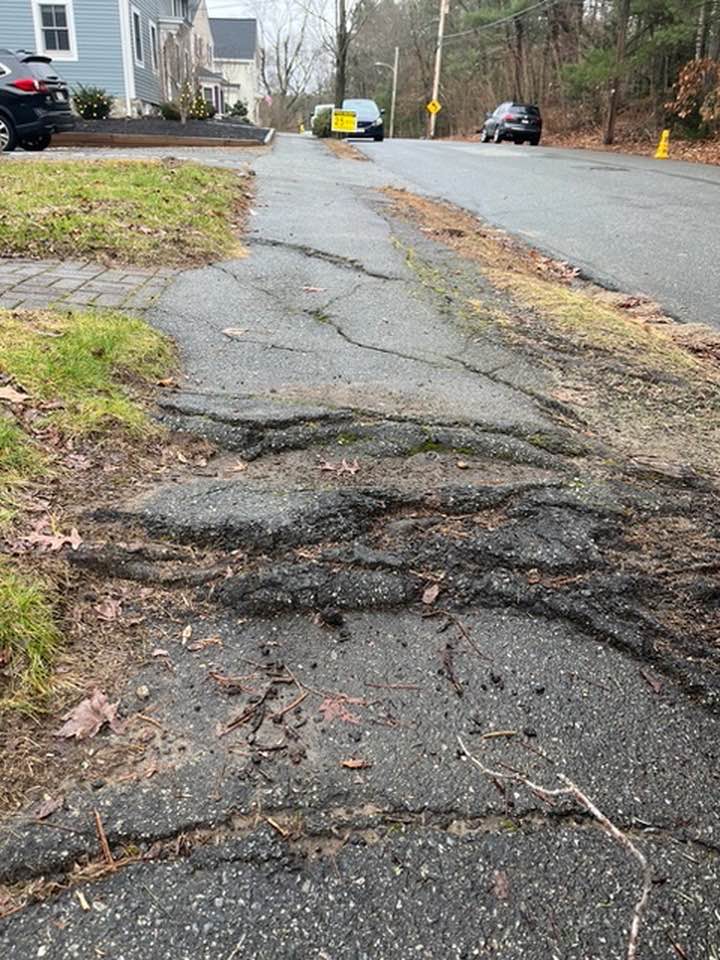
Due Diligence or Disregard? – According to Andover’s By-Laws, “areas subject to protection under the corresponding bylaw are any bank, freshwater wetland, isolated vegetated wetland, marsh, wet meadow, bog, swamp, vernal pool, reservoir, pond, creek, river or stream, or any land under said waters, or any land within 100 feet of the aforesaid resource areas, or land subject to flooding, or within 200 feet of the extent of mean annual high water of any river (collectively, the “resource areas protected by this bylaw”) (Section 3.1.) any activity proposed or undertaken … requires formal review by the Conservation Commission.
The proposed BSC Group design involves excavating and filling with asphalt a multi-use path that will run within a few feet of a “reservoir” at the south-west end, parking lots that will require the filling of vernal pools and wetlands, among other changes. It ought to be subject to Planning Board formal review even if it is a municipal facility.
We don’t understand why this hasn’t been scheduled in accordance with our understanding of the law. Neither the Planning Board or the town’s counsel have responded to multiple residents’ queries on this.
InAppropriations – the town could have presented this project as part of the annual budget in the 2023 or 2024 annual town meetings. Instead, it chose to use ARPA funds for the initial matching funds required by Masstrails. In 2023 it transferred a further $950,000 from APRA funds to the Parks & Recreation budget ostensibly to cover the cost of the trail that will exceed the initial $750,000 phase.
The lack of public input on use of ARPA funds in Andover (compared to other Massachusetts towns) is its own topic. In this specific case, it seemed to us that their use is intended to avoid a vote on any aspect of this project.
“Connected” Streets / Disconnected from Nature
The insistence by town employees and leadership on two features : asphalt paving and a minimum 10 foot width – cannot be explained by ADA regulations. They can be explained, however, if one seeks to comply with the Mass. DOT’s requirements for a “shared use” path. Paved shared use paths, however, are not required for accessibility. Indeed, people with certain disabilities may find them painful or difficult to use because of the hardness or the higher heat in summer months. Why, we wondered, couldn’t the town settle on a compromise solution such as stone dust to improve access for users of wheel chairs or mobility devices while not removing access for the disabled affected by impact or heat that use this trail specifically due to its softer surface? The latter group of disabled cannot use an asphalt trail due to the hard surface and high heat conductivity. Stone dust is used throughout our state and national park system with great success, would also mollify concerns about the risks to water and nature.
Our answer came at the public meeting to present the “Connected Andover” initiative to build a series of bike lanes and paved shared-use paths throughout town. The purpose of this initiative -to enhance recreational and commuting options by connecting residents to bike paths in Lowell and other nearby communities – is not problematic. It’s even welcome to many of us.
However, a salient detail in the map of planned bike paths (see below) indicates that the Haggetts Pond trail already demarcated as future bike lane. that
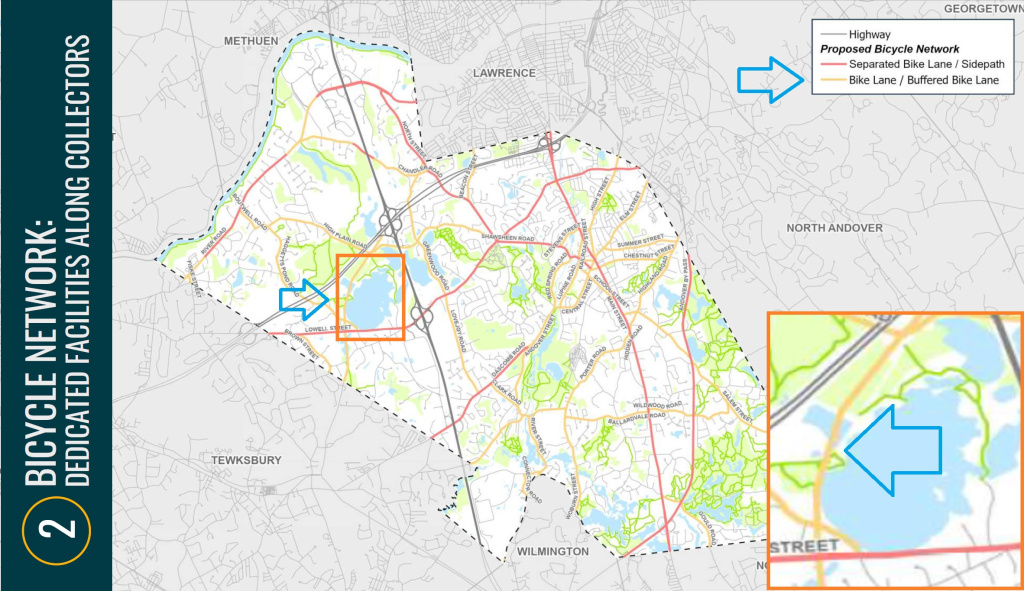
This is further confirmed in the Mass DOT website that already indicates the Haggetts Pond rail trail as a future bike path.
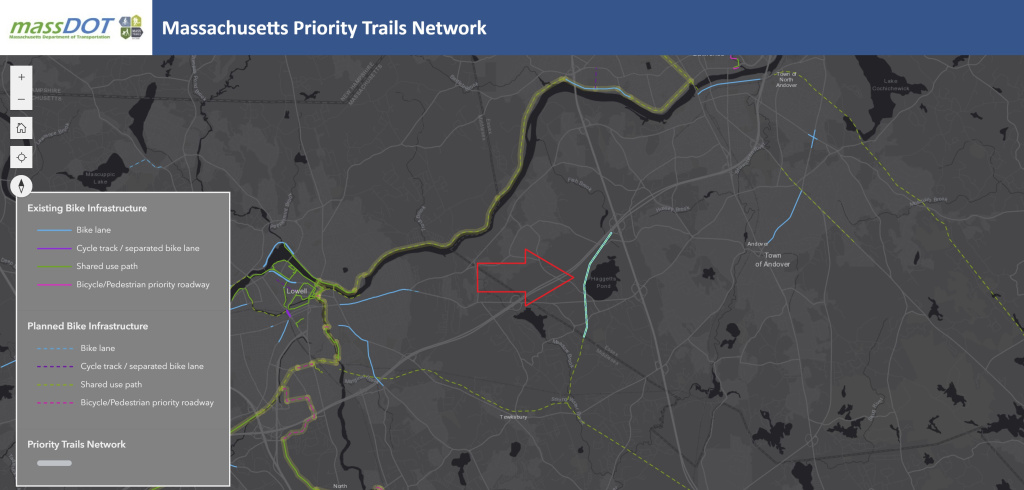
True Intentions Revealed
Friends of Haggetts pond thought all this time that the issue was about providing the disabled access to a natural treasure near our sensitive drinking water supply. In the end, the passion for asphalt seems driven by some town officials’ desire to create a commuting and recreational throughfare. That will forever alter the natural landscape around the trail, damaging the beauty and peace that disabled residents wanted to access in the first place!
We do not doubt that certain members of the town’s boards and employees truly look at the BSC Group asphalt-paved trail as the best thing that the town could offer to disabled residents. We trust that in their hearts, they believe they are primarily working toward that end.
However, after encountering the Haggetts Pond trail not only in Andover’s “Connected” presentation but the state’s own Department of Transportation trail plan despite the lack of any discussion of this initiative and policy until now, we find the answer as to why the town as conducted itself in the manner described above as obvious. The refusal to compromise on asphalt is clear since they have been planning this “shared path” as part of a spur connecting commuters to a future Andover – Lowell bike path or lane.
What policy drives this? These are ideas favored by Rails to Trails and Mass DOT. They are part of a deeply driven, probably heavily career enhancing and incented movement not just here in Northeast, but across the US. It will be a feather in the cap to any town leadership that implements one of these Rail Trail “shared paths”.
.
The ADA access purpose can now be understood as an emotional wedge that serves two purposes. The town can conceal the actual intent, lauding this path that exceeds ADA standards as benefitting disabled residents, and shame anyone against it (as if we don’t care about our disabled neighbors).

